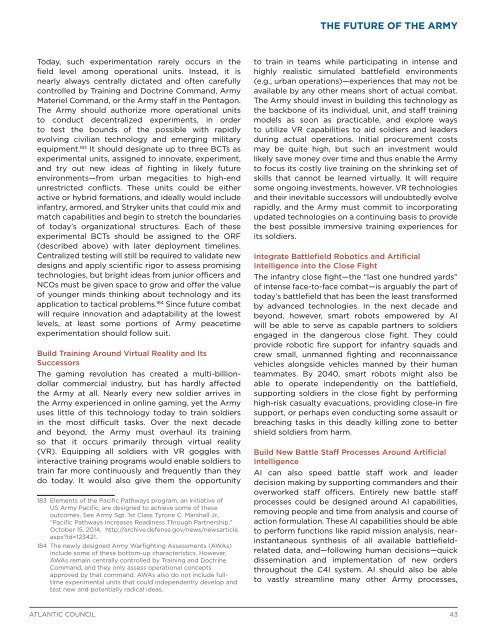FUTURE ARMY
Future_of_the_Army_web_0921
Future_of_the_Army_web_0921
Create successful ePaper yourself
Turn your PDF publications into a flip-book with our unique Google optimized e-Paper software.
THE <strong>FUTURE</strong> OF THE <strong>ARMY</strong><br />
Today, such experimentation rarely occurs in the<br />
field level among operational units. Instead, it is<br />
nearly always centrally dictated and often carefully<br />
controlled by Training and Doctrine Command, Army<br />
Materiel Command, or the Army staff in the Pentagon.<br />
The Army should authorize more operational units<br />
to conduct decentralized experiments, in order<br />
to test the bounds of the possible with rapidly<br />
evolving civilian technology and emerging military<br />
equipment. 183 It should designate up to three BCTs as<br />
experimental units, assigned to innovate, experiment,<br />
and try out new ideas of fighting in likely future<br />
environments—from urban megacities to high-end<br />
unrestricted conflicts. These units could be either<br />
active or hybrid formations, and ideally would include<br />
infantry, armored, and Stryker units that could mix and<br />
match capabilities and begin to stretch the boundaries<br />
of today’s organizational structures. Each of these<br />
experimental BCTs should be assigned to the ORF<br />
(described above) with later deployment timelines.<br />
Centralized testing will still be required to validate new<br />
designs and apply scientific rigor to assess promising<br />
technologies, but bright ideas from junior officers and<br />
NCOs must be given space to grow and offer the value<br />
of younger minds thinking about technology and its<br />
application to tactical problems. 184 Since future combat<br />
will require innovation and adaptability at the lowest<br />
levels, at least some portions of Army peacetime<br />
experimentation should follow suit.<br />
Build Training Around Virtual Reality and Its<br />
Successors<br />
The gaming revolution has created a multi-billiondollar<br />
commercial industry, but has hardly affected<br />
the Army at all. Nearly every new soldier arrives in<br />
the Army experienced in online gaming, yet the Army<br />
uses little of this technology today to train soldiers<br />
in the most difficult tasks. Over the next decade<br />
and beyond, the Army must overhaul its training<br />
so that it occurs primarily through virtual reality<br />
(VR). Equipping all soldiers with VR goggles with<br />
interactive training programs would enable soldiers to<br />
train far more continuously and frequently than they<br />
do today. It would also give them the opportunity<br />
183 Elements of the Pacific Pathways program, an initiative of<br />
US Army Pacific, are designed to achieve some of these<br />
outcomes. See Army Sgt. 1st Class Tyrone C. Marshall Jr.,<br />
“Pacific Pathways Increases Readiness Through Partnership,”<br />
October 15, 2014, http://archive.defense.gov/news/newsarticle.<br />
aspx?id=123421.<br />
184 The newly designed Army Warfighting Assessments (AWAs)<br />
include some of these bottom-up characteristics. However,<br />
AWAs remain centrally controlled by Training and Doctrine<br />
Command, and they only assess operational concepts<br />
approved by that command. AWAs also do not include fulltime<br />
experimental units that could independently develop and<br />
test new and potentially radical ideas.<br />
to train in teams while participating in intense and<br />
highly realistic simulated battlefield environments<br />
(e.g., urban operations)—experiences that may not be<br />
available by any other means short of actual combat.<br />
The Army should invest in building this technology as<br />
the backbone of its individual, unit, and staff training<br />
models as soon as practicable, and explore ways<br />
to utilize VR capabilities to aid soldiers and leaders<br />
during actual operations. Initial procurement costs<br />
may be quite high, but such an investment would<br />
likely save money over time and thus enable the Army<br />
to focus its costly live training on the shrinking set of<br />
skills that cannot be learned virtually. It will require<br />
some ongoing investments, however. VR technologies<br />
and their inevitable successors will undoubtedly evolve<br />
rapidly, and the Army must commit to incorporating<br />
updated technologies on a continuing basis to provide<br />
the best possible immersive training experiences for<br />
its soldiers.<br />
Integrate Battlefield Robotics and Artificial<br />
Intelligence into the Close Fight<br />
The infantry close fight—the “last one hundred yards”<br />
of intense face-to-face combat—is arguably the part of<br />
today’s battlefield that has been the least transformed<br />
by advanced technologies. In the next decade and<br />
beyond, however, smart robots empowered by AI<br />
will be able to serve as capable partners to soldiers<br />
engaged in the dangerous close fight. They could<br />
provide robotic fire support for infantry squads and<br />
crew small, unmanned fighting and reconnaissance<br />
vehicles alongside vehicles manned by their human<br />
teammates. By 2040, smart robots might also be<br />
able to operate independently on the battlefield,<br />
supporting soldiers in the close fight by performing<br />
high-risk casualty evacuations, providing close-in fire<br />
support, or perhaps even conducting some assault or<br />
breaching tasks in this deadly killing zone to better<br />
shield soldiers from harm.<br />
Build New Battle Staff Processes Around Artificial<br />
Intelligence<br />
AI can also speed battle staff work and leader<br />
decision making by supporting commanders and their<br />
overworked staff officers. Entirely new battle staff<br />
processes could be designed around AI capabilities,<br />
removing people and time from analysis and course of<br />
action formulation. These AI capabilities should be able<br />
to perform functions like rapid mission analysis, nearinstantaneous<br />
synthesis of all available battlefieldrelated<br />
data, and—following human decisions—quick<br />
dissemination and implementation of new orders<br />
throughout the C4I system. AI should also be able<br />
to vastly streamline many other Army processes,<br />
ATLANTIC COUNCIL<br />
43


